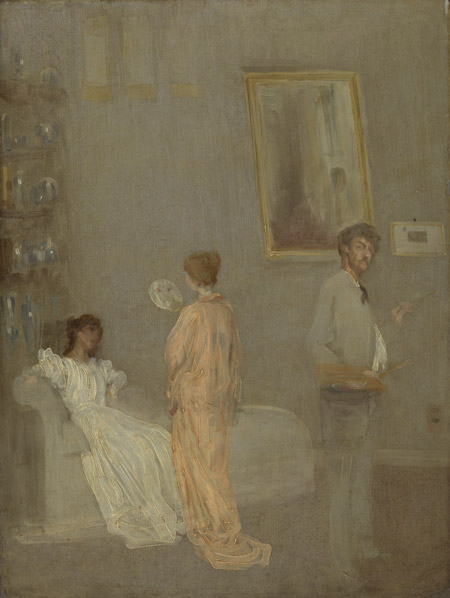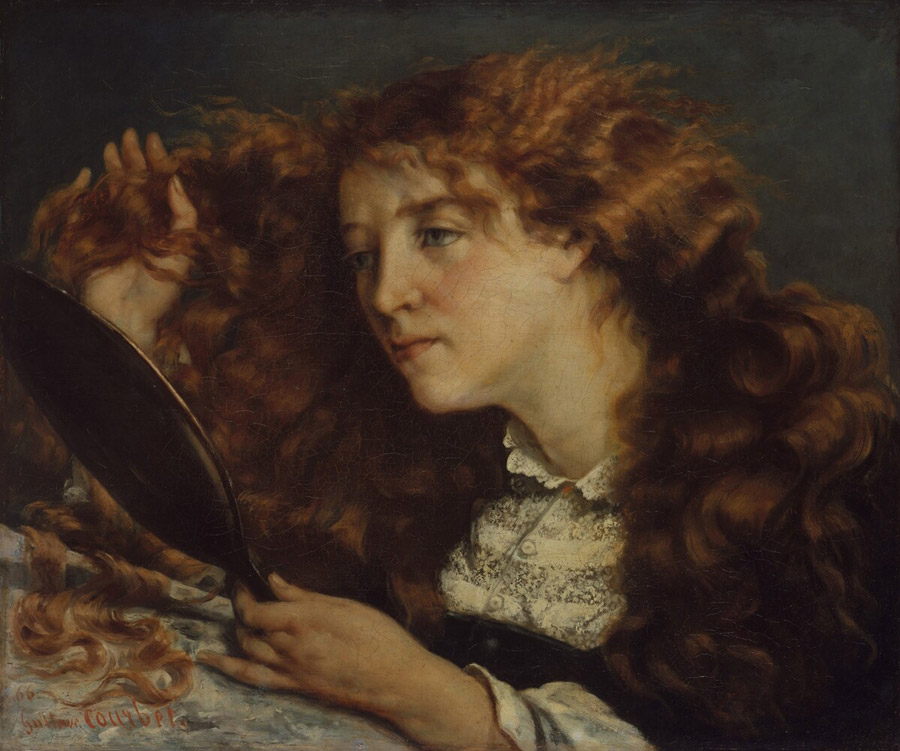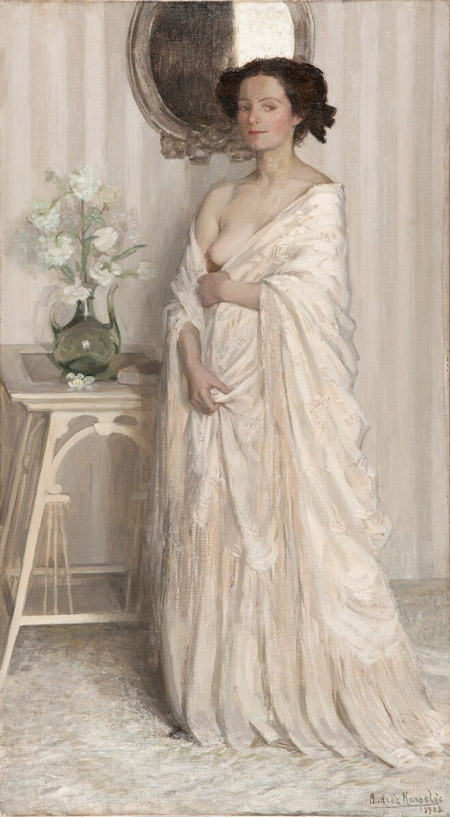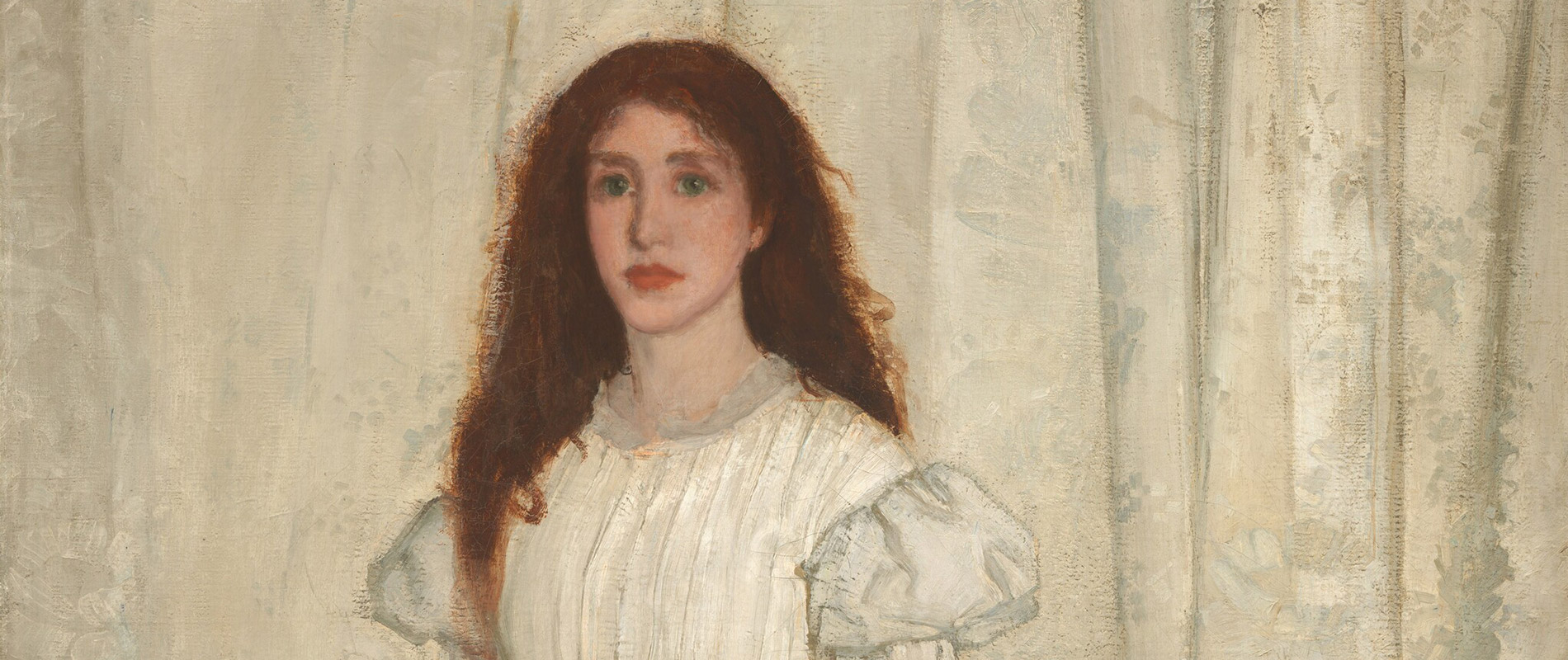Introduction
Joanna Hiffernan, an Irish immigrant to London, played a critical role in the art and life of American expatriate artist James McNeill Whistler. During the early 1860s she worked closely with Whistler, primarily as a model, on innovative paintings, prints, and drawings that challenged prevailing cultural norms and established Whistler’s reputation as one of the most influential artists of the late 19th century. The Woman in White: Joanna Hiffernan and James McNeill Whistler represents the first concerted effort to better account for what is hidden in plain sight in so many of Whistler’s celebrated early works: Hiffernan herself.
Joanna Hiffernan

James McNeill Whistler,
Unraveling the mystery of Joanna Hiffernan’s identity depends upon two types of evidence: biographical facts and works of art. Only a handful of her letters and no photographs survive. Baptized in Ireland in 1839, she migrated with her family to London by June 1843. She met Whistler in 1860 and within a year became the artist’s chief model. Romantically partnered with Whistler for five years, Hiffernan helped to manage his studio even after their relationship ended. Later, with her sister Agnes, Hiffernan raised a child, Charlie Hanson, who Whistler fathered with another woman. Hiffernan remained an integral part of Whistler’s life until her death in 1886 at the age of 46.
Outsiders Together

James McNeill Whistler, The Artist in His Studio (Whistler in His Studio), 1865/1872, 1895, oil on paper mounted on panel, The Art Institute of Chicago, Friends of American Art Collection, 1912.141. Image: The Art Institute of Chicago/Art Resource, NY
Hiffernan and Whistler came from different backgrounds and left their native countries for different reasons. Hiffernan’s impoverished family fled Ireland shortly before the Great Famine. Whistler left his middle-class family in 1855 to study art in Paris. Outsiders in England, they lived together as an unmarried couple despite the strict moral codes of the Victorian era and in defiance of English prejudice against the Irish. When civil war erupted in the United States in 1861, Whistler, a Northerner who briefly attended the military academy at West Point, expressed his support for the Confederacy but remained abroad. Whistler and Hiffernan never returned to their home countries.
Hiffernan in the World

James McNeill Whistler,
Operating on the margins of London society, Whistler and Hiffernan gravitated to the crowded, working-class district of Wapping on the banks of the polluted River Thames. They frequented the Angel Inn, a pub that became the setting for the painting Wapping (1860–1864). At the center, amid the gritty details of life along the river, a woman—modeled by Hiffernan—presides over the scene. Her pose and dress (including a neckline that may have been slightly risqué for audiences at the time) suggest she represents one of the thousands of women in London who earned incomes by engaging in sex work.
The Woman in White

James McNeill Whistler,
The most iconic, full-length portrait of Hiffernan (originally titled The White Girl) was advertised at a commercial gallery as “The Woman in White,” a reference to the acclaimed mystery novel by Wilkie Collins (1859). Whistler refuted the association, claiming, “My painting simply represents a girl dressed in white standing in front of a white curtain.” A few years later, Whistler took a different stance, asserting that the painting was an aesthetic experience analogous to music, a “symphony in white.”
None of the proposed titles acknowledged what would have been a particularly disconcerting aspect of the painting, especially for London audiences: the imposing presence, on a scale usually reserved for grand manner portraits of wealthy and powerful subjects, of a working-class Irish immigrant with little social standing.
Visual Music

James McNeill Whistler, Symphony in White, No. 3, 1865–1867, oil on canvas, The Henry Barber Trust, The Barber Institute of Fine Arts, The University of Birmingham, 39.24. Image: Bridgeman Images
Offering only hints of context, The White Girl mystified viewers. In 1867, after creating two more paintings of Hiffernan in white dresses (Symphony in White, No. 2: The Little White Girl and Symphony in White, No. 3), Whistler grouped the three together under a shared musical vision: “Symphonies in White.” These carefully arranged interiors heralded the then-radical mantra "art for art's sake"—the artist's effort to represent purely aesthetic concerns of tone, color, and form, rather than attempting to depict a scene realistically. In 2022, all three “Symphonies in White” will be displayed together for the first time in the United States in the exhibition The Woman in White: Joanna Hiffernan and James McNeill Whistler.
Hiffernan in Print

James McNeill Whistler,
In addition to paintings, Hiffernan posed for many of Whistler’s smaller, more intimate prints. In Weary, the dense weave of black marks that constitute her hair and torso give way to the spare, open white spaces of the skirt below. The shift from black to white, and from realism to abstraction, mirrors the transition between waking and sleeping. Whistler rendered Weary in six different states and numerous impressions, as artist and model explored subtle gradations of consciousness.
Hiffernan and Courbet

Gustave Courbet, Jo, la belle Irlandaise, 1865–1866, oil on canvas, The Metropolitan Museum of Art, H. O. Havemeyer Collection, Bequest of Mrs. H. O. Havemeyer, 1929, 29.100.63
“Do you remember Trouville and Jo . . . she had the spirit and distinction of art,” French artist Gustave Courbet fondly recalled in a letter to Whistler. The trio worked together for a short time in Trouville, on the northwest coast of France, in the fall of 1865. Whistler and Courbet created seascapes, and Courbet also painted portraits of Hiffernan. In one of these works Hiffernan considers her reflection in a hand mirror, an art historical trope that suggests both the power and impermanence of a woman’s beauty. Courbet is the only other artist known to have depicted Hiffernan.
Women in White

Andrée Karpelès, Symphonie en blanc, 1908, oil on canvas, Musée d’Arts de Nantes, Inv. 2071. Image: Cécile Clos/Musée d’Arts de Nantes, © rights reserved
From the time of its first exhibition to today, Joanna Hiffernan’s powerful image has inspired artists in the United States and Europe to create their own versions of “women in white.” John Singer Sargent, Gustav Klimt, and Fernand Khnopff explored and expanded the possibilities of Whistler’s template. Andrée Karpelès imbued her Symphonie en blanc (1908) with an unapologetic sexuality.
Photographers and painters from Alfred Stieglitz to Romaine Brooks, in concert with their respective subjects, Georgia O’Keeffe and Muriel Draper, reconsidered the significance of Hiffernan’s persona in new contexts. Vik Muniz’s powerful life-size photograph of a collage (2013) of Whistler’s painting incorporates hundreds of magazine images of women to examine issues of representation and agency prompted by The White Girl. In the exhibition planned for 2022, these and other works will explore the resonance of “women in white” from the late Victorian era through the current day.
